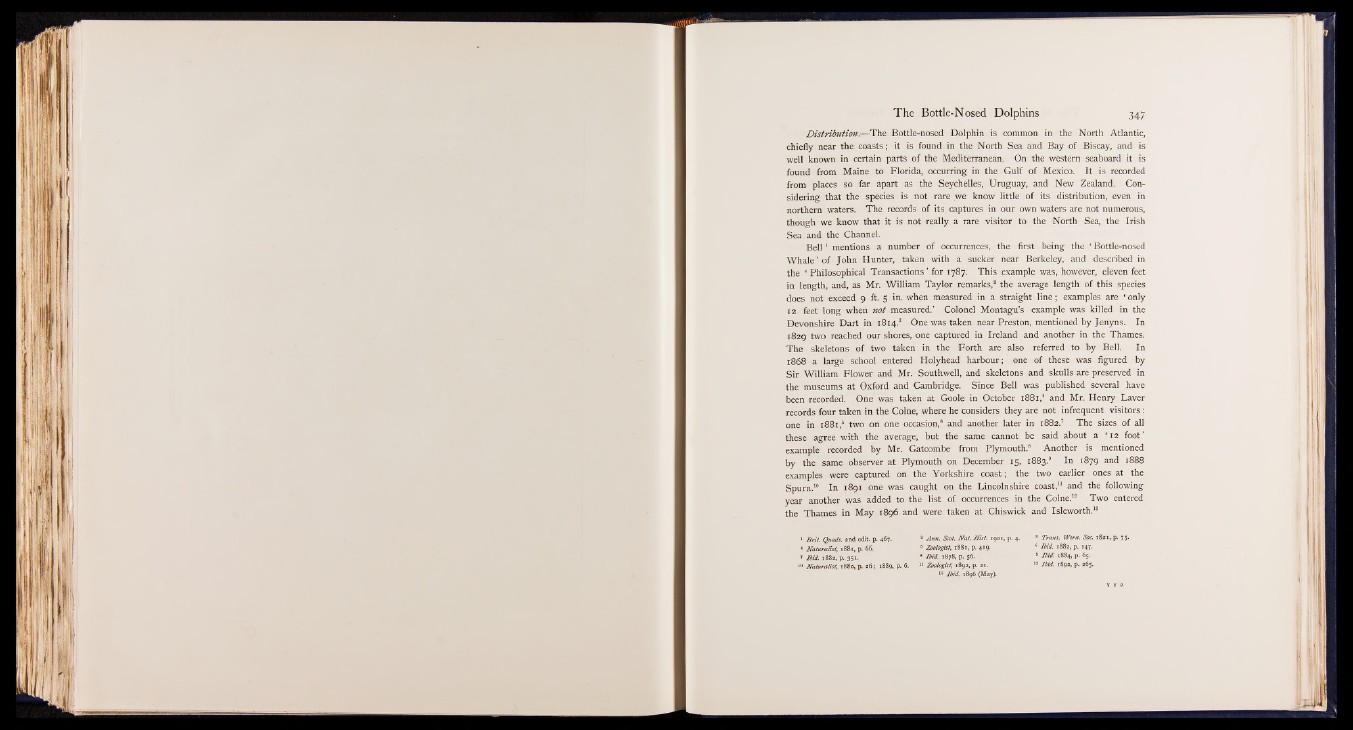
D istribution— The Bottle-nosed Dolphin is common in the North Atlantic,
chiefly near the coasts; it is found in the North Sea and Bay of Biscay, and is
well known in certain parts of the Mediterranean. On the western seaboard it is
found from Maine to Florida, occurring in the Gulf of Mexico. It is recorded
from places so far apart as the Seychelles, Uruguay, and New Zealand. Considering
that the species is not rare .we know little of its distribution, even in
northern waters. The records of its captures in our own waters are not numerous,
though we know that it is not really a rare visitor to the North Sea, the Irish
Sea and the Channel.
B e ll1 mentions a number of occurrences, the first being the ‘ Bottle-nosed
Whale ’ of John Hunter, taken with a sucker near Berkeley, and described in
the ‘ Philosophical Transactions ’ for 1787. This example was, however, eleven feet
in length, and, as Mr. William Taylor remarks,2 the average length of this species
does not exceed 9 ft. 5 in. when measured in a straight line; examples are ‘ only
12 feet long when not measured.’ Colonel Montagu’s example was killed in the
Devonshire Dart in 1814.8 One was taken near Preston, mentioned by Jenyns. In
1829 two reached our shores, one captured in Ireland and another in the Thames.
The skeletons of two taken in the Forth are also referred to by Bell. In
1868 a large school entered Holyhead harbour; one of these was figured by
Sir William Flower and Mr. Southwell, and skeletons and skulls are preserved in
the museums at Oxford and Cambridge. Since Bell was published several have
been recorded. One was taken at Goole in October 1881,4 and Mr. Henry Laver
records four taken in the Colne, where he considers they are not infrequent visitors:
one in 1881,6 two on one occasion,6 and another later in 1882.7 The sizes of all
these agree with the average, but the same cannot be said about a ‘ 12 foot’
example recorded by Mr. Gatcombe from Plymouth.8 Another is mentioned
by the same observer at Plymouth on December 15, 1883.9 In 1879 and 1888
examples were captured on the Yorkshire coast; the two earlier ones at the
Spurn.10 In 1891 one was caught on the Lincolnshire coast,11 and the following
year another was added to the list of occurrences in the Colne.12 Two entered
the Thames in May 1896 and were taken at Chiswick and Isleworth.18 *
1 B rit. Quads, and edit. p. 467.
4 Naturalist, 1881, p. 66.
7 Ibid. 1882, p. 351.
10 Naturalist, 1880, p. 26; 1889, p. 6.
* Ann. Scot. Nat. H ist. 1901, p. 4.
8 Zoologist', i88x, p. 419.
8 Ibid. 1878, p. 56.
11 Zoologist, 1892, p. 21.
13 Ibid. 1896 (May).
8 Trans. Wem. Soc. 1821, p. 75.
6 Ibid. 1882, p. 147.
9 Ibid. 1884, p. 65.
19 Ibid. 1892, p. 265.